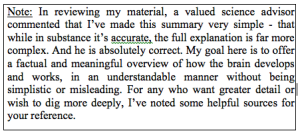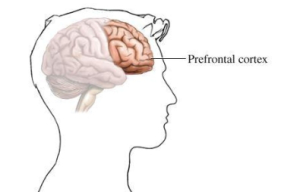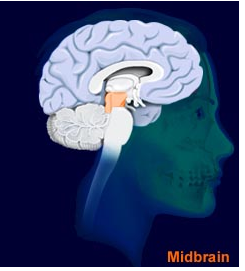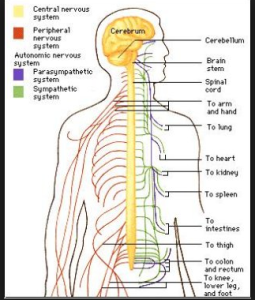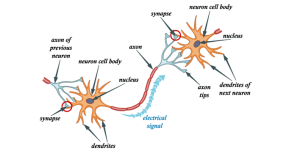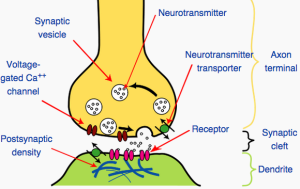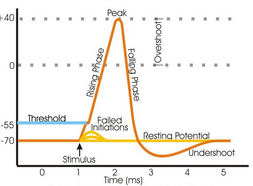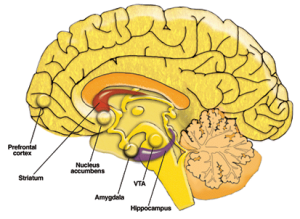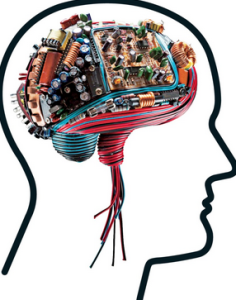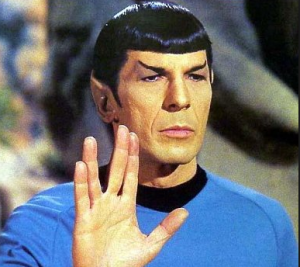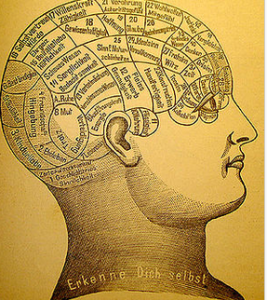Brain Science: Part 1
I was served my first taste of addiction brain science by the lead member of my advisory board in early 2009, and I was hooked. I just couldn’t get enough of it. (Pardon the word choice.) Bottom line, brain science is tremendously exciting, highly logical, constantly evolving and surprisingly easy to understand. And for that reason, it can be seductive, giving us a sense of clearly understanding things very complex, when in truth, complete understanding of the brain is beyond anyone’s reach at this time, or perhaps at any time.
That said, to get a better understanding of addiction, we first must have a better understanding of the brain. That includes taking on some of the “truths” being taught about the brain and addiction; things that “everybody knows” but no one can prove, and some that simply aren’t true. These misconceptions about the brain have become barriers to progress in our efforts to defeat addiction and they must be removed so that we can move forward.
So with that as my qualifier, the following offers an overview of our 3-pound brain, the most wonderfully complex organ in our body – or anywhere.
Part 1 – Brain Basics: Brain Structure and Development; The Nervous System and How It Communicates
Part 2 – The Continually Developing Brain – Neurogenisis and Neuroplasticity; The Ongoing Mind/Brain Debate; Character and the Brain
Part 3 – Addiction Development, Treatment and Neuroethics – The Next Frontier
Brain Basics – How It Develops
We’ll begin by highlighting the critical brain areas and their basic functions, calling out those most directly associated with addiction.
The human brain develops from back to front and from the inside out, until all regions are formed. A person’s prefrontal cortex (PFC) is the last region to form and is still developing until he or she is at least 24 or 25 years of age[i]. This area of the brain, referred to as our executive region, houses our faith, values, morals, beliefs, judgment, impulse control, decision-making and strategic planning capabilities. The fact that it is not fully formed until our mid-20’s helps explain why young people tend to be impulsive and are inclined to high-risk behaviors. When we wonder why our teens sometimes “act like they have half a brain,” it’s at least partly because their brains are still under construction.
The late-developing PFC plays at least two critical roles in addiction:
- It contributes to 85% of all young people taking the risk of experimenting with drugs and alcohol before they reach 17 years of age.
- It raises questions about whether young people are capable of developing full-blown addiction given that its closing bond is with the mature PFC. More on this later.
Brain Basics: The Parts
The brain can be divided in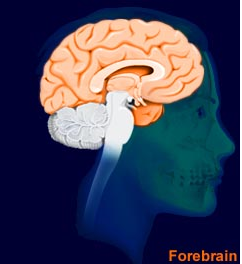 to three segments: The hindbrain, midbrain and forebrain. The hindbrain is the first area to develop and includes the upper part of the spinal cord, brain stem and cerebellum. It controls our autonomic, or unconscious, vital functions such as respiration and heart rate, and coordinates our movements.
to three segments: The hindbrain, midbrain and forebrain. The hindbrain is the first area to develop and includes the upper part of the spinal cord, brain stem and cerebellum. It controls our autonomic, or unconscious, vital functions such as respiration and heart rate, and coordinates our movements.
The midbrain develops next. In the upper part of the brainstem, the midbrain is responsible for our sensory processes and for transmitting information between the hindbrain and forebrain. It houses the ventral tagmental area (VTA), a region involved in processing sensation-related input, and central to our understanding addiction.
And finally, the foreb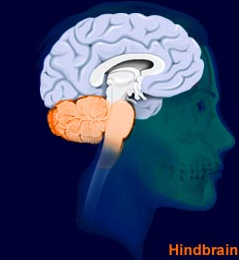 rain, the largest and most complex part of our brain, processes input from throughout the brain and body to become thought and action. It houses the limbic system (processes emotions and memory), thalamus (relay station for information entering forebrain, also regulates sleep), hypothalamus (regulates response to pleasure and pain, signaling autonomic and hormonal systems), basal ganglia (critical to forming habitual behaviors), and cerebral cortex (80% of brain, responsible for high-level behavior and mental processing, prefrontal cortex).
rain, the largest and most complex part of our brain, processes input from throughout the brain and body to become thought and action. It houses the limbic system (processes emotions and memory), thalamus (relay station for information entering forebrain, also regulates sleep), hypothalamus (regulates response to pleasure and pain, signaling autonomic and hormonal systems), basal ganglia (critical to forming habitual behaviors), and cerebral cortex (80% of brain, responsible for high-level behavior and mental processing, prefrontal cortex).
Addiction develops over time and at some point, involves each of these three brain areas.
The Nervous System
Referred to as the body’s control and communication network, the brain’s nervous system is responsible for receiving and processing all information in the body. It’s divided into two sections: the central nervous system (CNS) made up of the brain and spinal cord; and the peripheral nervous system (PNS) composed of our sensory organs and all the nerves that connect them with the rest of our body. Very simply, the organs and nerves of the PNS sense and transmit information about conditions inside and outside the body to the CNS where it is evaluated before sending signals back through the PNS to the various parts of the body to regulate their operation.
Though people’s nervous systems all follow the same general methods of operation, every person’s system is unique, contributing to each of us experiencing the same event, flavor, smell, interaction, or any other stimulus or sensation, differently. The fact of our distinct responses to like stimuli helps explain our differing tastes and preferences in lifestyle, entertainment, activities, relationships, food, fashion and more. And it plays a role in people developing their own preferred manners of behavior that, in some cases, can grow into dependencies and even addiction.
How Brain Cells Communicate
Our nervous system is made up of two types of cells: Neurons and the Glial cells that support them. Our neurons – billions of them – are the communicators of our nervous systems. Though each neuron is designed with the same basic elements – antennae-like dendrites to receive information, a cell body to process it, and an axon to pass the information along to other neurons, muscles and glands – their specific architecture, such as individual dendrite branching patters, varies.
Note: Though for decades, communication has been thought to flow only in one direction through a neuron (from dendrite – to cell body – to axon) a recent study by German neuroscientists reports on possible exceptions[ii]. This is relevant to our discussion only as it underscores the point that long-held beliefs about the brain are being changed as technology opens new windows that let us see and understanding how the brain actually functions. For the sake of this overview, however, we will stick with the one-way information flow that applies in most cases.
Along the neuron’s axon are vesicles, balloon-like structures filled with one of 60+ types of brain chemicals or neurotransmitters[iii]. And while we generally think of the different types of neurotransmitters as having a single function, scientists are learning that each can play a variety of roles and even interact with other neurotransmitter types to serve still more purposes[iv]. For example, one of the most studied neurotransmitters, and at the heart of our understanding addiction, is dopamine which is best known for its role in communicating reward or pleasure, but also is recognized for its involvement in memory, learning, motivation and more.
When properly signaled by incoming messages, vesicles release their load of neurotransmitters through terminal buttons, bulbous structures at the end of each axon, where they travel across a synapse, a gap between the axon of one neuron and the dendrites of another.
There the neurotransmitters bind with corresponding receptors to activate the next neuron, pass along their message, and then be recycled or destroyed. This pattern is repeated along a neural path for final message delivery at a specified point – an area of the brain, muscle or gland – to initiate or inhibit an action or response.
We need to note here that neurotransmitters only can be effective in handing off information if corresponding receptors are ready and able to bind, receive and send the message on to the next stop.
Meeting Thresholds
While the brain’s communi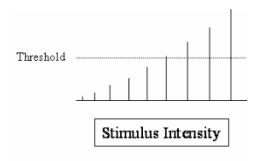 cation system is pretty straightforward, certain conditions must be met at each step for transmission to continue to a destination. For starters, the neural transmission process cannot begin until the originating signal, or stimulus, meets a minimum intensity threshold sufficient to cue waiting vesicles to release their neurotransmitters into a synapse adjacent to another neuron.
cation system is pretty straightforward, certain conditions must be met at each step for transmission to continue to a destination. For starters, the neural transmission process cannot begin until the originating signal, or stimulus, meets a minimum intensity threshold sufficient to cue waiting vesicles to release their neurotransmitters into a synapse adjacent to another neuron.
To continue, appropriate receptors must be ready and able to bond briefly with the neurotransmitters, take their message and pass it along to the cell body where it will move into the axon. Then, if threshold levels again are met, waiting vesicles will be signaled to release their neurotransmitters to the next stop. 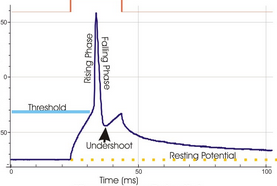
Threshold levels vary among neural systems of all individuals, with none being better or worse than another. But unless and until a stimulus reaches an established threshold level, if it undershoots the threshold, the waiting neurotransmitters will not be released.
It’s an all or nothing situation. This point is critical to understanding how people develop addiction.
Let’s take an example with three friends. Two of the friends have high thresholds requiring intense stimuli for experiencing sensations of pleasure, while the third has a low threshold level. All three go out and experiment with substances. All three experience the extreme sensation produced by the substances. The next day, the friend with a low threshold resumes everyday pleasurable experiences, such as watching movies or walking in the park, and feels a desired reward.
One of the two friends with high thresholds is a competitive swimmer, and the next day returns to a rewarding routine of strenuous work-outs and interaction with teammates. The third friend, also with a high threshold, does not feel rewards from simple daily activities, is not immersed in any extremely stimulating academic, athletic, music or other intense activity, and after experimenting with substances, resumes a life that offers little feeling of reward. The next time this person feels a compelling need for something more, and has not yet found a productive highly stimulating pursuit, he or she now knows how to get it.
Neural Communication and Motivation
The chain of communication, from the originating stimulus to an individual’s ultimate response, is the same basic process in all people. But as mentioned earlier, in reaction to a shared stimulus, no two people will release and transmit the same volume of neurotransmitters at the same level or in the same timeframe. And as an effect, each person will experience that same stimulus in his or her own unique manner.
While for one person, the stimulus might exceed the minimum threshold to release great volumes of a neurotransmitter leaving them feeling great reward, for another, the same stimulus might be insufficient, and they might feel no pleasure in response. One is not “normal” and the other in need of correction. What we do have is one person that is satisfied with the stimulus, and another that will be motivated to seek more. They are unique, just as they were designed.
It is critical to note a couple of things at this point.
- Wanting to feel a reward or pleasure is not a hedonistic desire. It is a basic human need that motivates us and drives our choices and behavior. People will find a way to feel pleasure; it’s just a matter of how.
- As of this date, no one can objectively measure neurotransmitter volumes, though several research institutes are nearing methods that might get us close[v]. The obvious implication is that without a means to measure neurotransmitter counts, it is impossible to set an objective norm for stored, released or transmitted neurotransmitter volumes.
 Without an objective norm or standard, we cannot determine whether a neural system is functioning within or outside a normal range. And we certainly cannot objectively identify any neurotransmitter system to be functioning improperly, or to be “dysregulated.” meaning there is an “impairment of the physiological regulatory mechanism” resulting in too little neurotransmitter being released in response to a control stimulus.
Without an objective norm or standard, we cannot determine whether a neural system is functioning within or outside a normal range. And we certainly cannot objectively identify any neurotransmitter system to be functioning improperly, or to be “dysregulated.” meaning there is an “impairment of the physiological regulatory mechanism” resulting in too little neurotransmitter being released in response to a control stimulus.
For decades however, the addiction industry has defined addiction as a chronic disease or condition stemming from a dysregulation of the (mesolimbic) neurotransmitter (dopamine) system, and has encouraged medication as part of its treatment to offset the effects of the impairment. To state the obvious, given that NT volumes cannot be measured, not only are we unable to objectively diagnose a neurotransmitter system as being dysregulated, but we also are unable to objectively evaluate the effect of any medications on the system’s performance.
What we can do is draw reasonable assumptions about addiction or related conditions by correlating a person’s symptoms and behavior with our understanding of the brain, how it operates, and how it might contribute to the symptoms.
For example, it would be reasonable to assume that a substance dependent person had a high reward threshold level that could be reached only through intense stimuli. But to draw a causal relationship between the two would suggest that all people that have high reward thresholds and experiment with substances become dependent on substances. And since we can estimate that about 40% of the people have reward thresholds somewhere above a standard or average level, and because nearly all people will experiment with substances, this cause-and-effect assumption does not hold up. Further, to say that those who do become dependent on substances are chronically so, implies that the brain cannot grow and learn new intense behaviors to replace the existing dependency – something that evidence suggests can be done, at any age. Much more on this when we discuss neurogenesis and neuroplasticity in Part 2.
Rational Brain – Emotional Brain
As the forebrain’s Prefrontal Cortex (PFC) is called our executive brain region and is principally involved in our more rational thinking, the Limbic System, a number of interconnected brain structures, is referred to as our emotional brain for its involvement with our feelings of reward, pleasure and overall mood. What is less known is that the system also carries messages that influence our memory and learning, and through pathways that extend into the prefrontal cortex, is involved in our decision-making.
Though not surprising that our emotions influence our decisions, the research uncovering neural connections that bring emotional messages into the brain’s rational processes is new, and not without contention. Like all things being revealed through new technology in brain science, this changes a lot of preconceptions from which other ideas have grown, and it requires a lot more study to understand its implications. In fact, there’s a relatively new field of Neuroeconomics[vi] that is dedicated to exploring this together with other neural processes influencing decision-making.
The limbic system, and its interplay with other brain regions and functions, especially with the PFC, is central to understanding addiction, and how to overcome it.
The Reward Pathway
The final brain area to be covered before we wrap up this section on brain basics is the Mesolimbic Dopamine System, also known as our reward pathway. Its name says it all. The pathway moves up from the central part (meso) of the brain and limbic system, and is the principle neural pathway for carrying messages of reward to critical brain regions, allowing us to feel varying degrees of reward or pleasure.
The system is the primary focus of addiction science. In fact, addiction has been defined as a direct effect of the Mesolimbic Dopamine System functioning in a manner outside the (assumed) normal levels of neurotransmitter dopamine transmission. Drawing from our earlier discussion, when the industry refers to a mesolimbic system “dysregulation leading people to use substances,” they likely are identifying a system distinguished by a high reward threshold – one that requires more intense stimuli to signal neurotransmitter dopamine release, and that some will satisfy with substance use.
This again begs the question of whether the high reward threshold is something inherently harmful, meaning substance use is the only expected outcome, or whether it merely is a powerful motivator, meaning it drives one to pursue more intense stimuli or behavior, without bias to the type of behavior chosen. But for now we’ll just address how the system works.
The reward pathway begins in the midbrain’s ventral tegmental area (VTA) where neurotransmitter (NT) dopamine is released in volumes relative to the intensity of stimuli. (The more intense the stimulus, the more NT-filled vesicles released) Released NT dopamine bind with appropriate receptors and the transmission process is underway.
The first major stop along the pathway is the Nucleus Accumbens (NAc) where the transmitted NT dopamine delivers a message of reward in proportion to the NT volume received. The Amygdla chimes in, helping to associate the source of a particular stimulus with its sensory response – whether it was rewarding or aversive (i.e. roller coaster ride felt thrilling, terrifying, nauseating). The hippocampus then stores a memory of the sensory experience and its context for access when the person wishes to repeat the feeling.
When the experience with its desired response are repeated enough times, the message advances to the pathway’s final stop, the prefrontal cortex, where it can form a meaningful bond and take on true significance to the individual.[vii] When the bonding involves drugs, alcohol or other harmful behaviors, it is identified as full-blown addiction. When it involves productive intense behaviors, it tends to be identified as exceptional.
Who’s In Charge?
This is a good place to stop and take on the big issue of whether we are at the mercy of our evolved brain and its electrochemical processes to determine how we think, feel and behave. The short answer is, absolutely not.
In later posts we’ll review opposing views in the emotional debate over this question of who’s really in charge? I’ll be asking for your input in hopes of broadening the discussion. But for now, since I’m running this blog, we’ll go with the position driving The Stand, which can be summed up as follows.
Our brain is a remarkable tool, uniquely designed by God to help each of us experience our environment distinctly and fully, sense how it makes us feel, and then use the information, as viewed through our faith and character, to form our own judgments and decisions about how to respond and proceed.
Part 2 of our discussion on brain science will be posted by January 1.
Imagine – 2015!
[i] D.Yurgelun-Todd, “Emotional and Cognitive Changes During Adolescence”, Neurobiology, April 2007
[ii] Berlin neuroscientists identify “wrong-way” neuron communication and filters to guard against excessive cell activation. http://www.charite.de/en/charite/press/press_reports/artikel/detail/informationsfluss_im_gehirn_ist_keine_einbahnstrasse/
[iii] To date 50 – 60+ different neurotransmitters identified, likely more remain to be found. http://www.utexas.edu/research/asrec/neuron.html
Dana Foundation discussion on neurotransmitters and new understanding of functions http://www.dana.org/News/Details.aspx?id=43536
[iv] Dana Foundation primer on neurotransmitters and how new information is changing how we understand their roles. http://www.dana.org/News/Details.aspx?id=43536
[v] patent application for method to measure neurochemicals in vivo
study giving first real time view of neurotransmitter release and where it travels, http://mcgovern.mit.edu/news/news/delving-deep-into-the-brain/http://techtransfer.universityofcalifornia.edu/NCD/19176.html
Another report on MIT study, explaining 3-D model of neurotransmitter activity http://cen.acs.org/articles/92/i18/Method-Provides-3-D-Map.html
[vi] The role of emotion in decision-making: A cognitive neuroeconomic approach Journal of Biomedical Informatics http://www.j-biomed-inform.com/article/S1532-0464(06)00045-1/fulltext
[vii] Ichan School of Medicine at Mt. Sinai, Neuroscience Dept, Nestler Lab http://neuroscience.mssm.edu/nestler/brainRewardpathways.html
BRAIN SCIENCE: PART 2
For some, all this talk about brain processes and neural communication might sound a bit too mechanical for comfort, as though the way we experience our emotions and what drives our behavior is merely a function of a series of electrochemical processes. And while there is a segment in science and society that subscribes to that line of thinking, we’re about to get into some amazing findings from brain research that clearly point to our role as conscious individuals to direct, and redirect as suits us, how we choose to respond to the various stimuli around us and the feelings they engender.
Let’s examine a typical day in the life of You. You wake up, feel hungry, and smell fresh coffee and bacon. You know the smells, remember how good the food tastes, and head straight for the kitchen, eager to chow down. In the background you hear the morning news coming from the kitchen TV and remember that you neglected to respond to your boss’ email last night as you promised. You hear your dog whining at the door and know it’s time to let him out. But as you head to open the door, you get a text from a friend saying she’s stranded on the highway and needs your help urgently.
All of this input has been received and processed in your brain, while at the same time its autonomic systems have regulated your life-sustaining bodily functions. But now you must consciously decide what to do next: Eat deli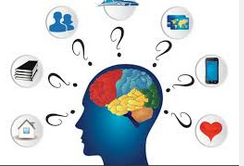 cious bacon and enjoy a mug of fresh coffee; answer the boss’ email before it’s too late; let the dog out before there’s a mess; or drop everything and go to the aid of your desperate friend. Your brain processed all the input shaping the options, but your Prefrontal Cortex, where selective judgments are made, isn’t going to tell you which option is the most important and needs tending to first. So how do you decide?
cious bacon and enjoy a mug of fresh coffee; answer the boss’ email before it’s too late; let the dog out before there’s a mess; or drop everything and go to the aid of your desperate friend. Your brain processed all the input shaping the options, but your Prefrontal Cortex, where selective judgments are made, isn’t going to tell you which option is the most important and needs tending to first. So how do you decide?
The multi-discipline field of decision-making science is exploding with new information and insight these days, with the focus remaining on activity within and interactions with the brain’s Prefrontal Cortex (PFC) where we shape our judgments, plans and decisions[i].
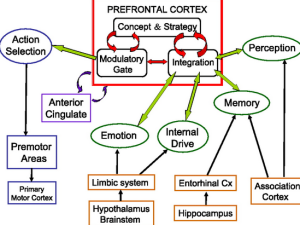 One recent finding that I mentioned earlier, involved the Limbic System communicating directly with the PFC, and the effect of our emotions influencing our conscious decision-making. Also in the PFC, mediating our emotions and our reasoning/thinking, is our individual character[ii] – the sum of our faith, values, morals, beliefs, interests, likes, dislikes and personality traits that we’ve developed and edited over the years to represent “who” or the “kind” of person we are. And so it’s no surprise that how we weigh different options and form our decisions and judgments, reflects the conscious interplay between what we think, how something makes us “feel” and “who” we have chosen to be as a person. This point goes right to the heart of understanding addiction and how we might effectively treat it.
One recent finding that I mentioned earlier, involved the Limbic System communicating directly with the PFC, and the effect of our emotions influencing our conscious decision-making. Also in the PFC, mediating our emotions and our reasoning/thinking, is our individual character[ii] – the sum of our faith, values, morals, beliefs, interests, likes, dislikes and personality traits that we’ve developed and edited over the years to represent “who” or the “kind” of person we are. And so it’s no surprise that how we weigh different options and form our decisions and judgments, reflects the conscious interplay between what we think, how something makes us “feel” and “who” we have chosen to be as a person. This point goes right to the heart of understanding addiction and how we might effectively treat it.
So in the scenario above, with your emotions and personal character influencing your conscious evaluation of the input your brain has assembled, what do you decide to do next?
I know there are people who teach that we are powerless against the forces of our brain and its drives. That certain brain characteristics influencing judgment and behavior are genetic, and that for some they are intrinsically harmful, something they must accept and learn to live with. I also know how easy it can be to believe all this, especially when facing daunting challenges such as addiction and you have been assured by experts that it’s a scientific fact.
How much simpler it is to believe that a person’s brain drove them to their harmful behaviors, 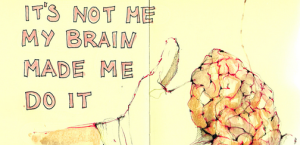 or that their actions are a function of some genetic brain irregularity, than it is to accept that the person’s own choices led to their current condition.
or that their actions are a function of some genetic brain irregularity, than it is to accept that the person’s own choices led to their current condition.
And how much easier it is accept that the condition cannot be reversed or changed, than it is to acknowledge that by regenerating their character and learning to make different choices consistent with their new character, the condition could be changed or overcome.
Thinking And Feeling
Let’s take a closer look at another long-held belief about our brain and behavior. For the country music fans out there, I think a Dierks Bentley song sums it up well, as he reflects on some really bad decisions regarding a pretty girl with an angry dad – “I know what I was feelin’, But what was I thinkin’?!!”
 Sorry Dierks, but in truth, our feeling and our thinking aren’t as distinct as believed.
Sorry Dierks, but in truth, our feeling and our thinking aren’t as distinct as believed.
New technology-driven research demonstrates that our brain regions, brain chemicals and hormones[iii] aren’t nearly as compartmentalized or narrowly defined as we had thought, quashing our ideas about people generally being driven by their emotions or by reason.
And all the talk about whether people were right or left brained? Similar studies, focused on cross-hemisphere neural pathways, reveal we no longer can identify ourselves as tending to be either right or left brained[iv].
In fact, the research findings demonstrate that what we had imagined to be clearly defined brain regions functioning as silos, each tending to its assigned tasks, isn’t so neatly explained after all[v]. What we’re learning instead is that there is considerable lateral communication[vi] between brain regions. And as we’ll get into in part 3, we’re finding that through training and in response to need, we can in effect rewire our brains, creating new cross-connections and learning.[vii]
In other words, there’s a lot more opportunity for cross-talk between brain areas than previously imagined, adding to our understanding of the complexity of brain processes and of the capability of our unique brains to integrate sensory, emotional and cognitive processes as we shape our individuality and form our decisions. This knowledge is HUGE as we look for new ways to work with our brain to overcoming addiction.
But let’s get back to Dierks Bentley and his reflections on how he came to some pretty bad decisions with unpleasant repercussions. 
The point is, while most of us will continue to experience quick, sometimes extreme, urges and other emotional responses to situations and events throughout out lives, we no longer can excuse our poor impulsive responses to our being at the mercy of our overactive right brains and emotions. The growing body of evidence underscores what we already intuitively knew, that we don’t have to wait until after we act rashly for our rational thinking and better judgment to weigh in on the decision process. Rather, we can learn character-based decision-making, in response to nearly any type of input, until our “ready-fire-aim” tendencies become natural “ready-aim-fire” judgments and decisions.
Sadly, those who teach the easy way of just accepting an overall powerlessness over our drives and impulses are grossly underestimating the capabilities of our amazing brain and the One who created it.
We Can and Do Learn, Grow and Change
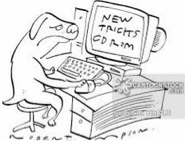 The common belief has been that once the Prefrontal Cortex is fully formed, our character is set or hard-wired in our brains – that who we had become, would be who we would remain. As explained earlier, recent studies have proved this to be false[viii]. In fact, through the process of neurogenesis, in which new neurons are produced, and of neuroplasticity, where existing neurons rewire themselves, or form new connections, our brains are continuously changing, even into our later years, as we experience, learn and grow [ix].
The common belief has been that once the Prefrontal Cortex is fully formed, our character is set or hard-wired in our brains – that who we had become, would be who we would remain. As explained earlier, recent studies have proved this to be false[viii]. In fact, through the process of neurogenesis, in which new neurons are produced, and of neuroplasticity, where existing neurons rewire themselves, or form new connections, our brains are continuously changing, even into our later years, as we experience, learn and grow [ix].
This remarkable capability of our brain allows us to change our individual character[x], not just on the surface, through certain outward behavior changes, but by purposefully assessing and re-defining what we believe, how we express our faith, morals, values, ethics, beliefs, interests and personality. In the same way we originally shaped our underlying character, we can choose the new kind of person we wish to be. Even well into our older age we can select and “try on” new individual traits, and carry them into our daily lives to experience their impact on how we think, feel, relate to others and such. Those we like, we can repeat and learn. Those that are not a fit, we can discard and give other a try.
The growing field of learning science, also referred to as neuroeducation, brain-compatible learning or brain-based learning, explains that as we take in new information, apply, repeat and learn it, our brain changes. Regardless of a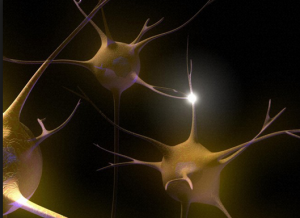 ge, new neurons can form, new connections form between existing neurons and existing connections between neurons get stronger.
ge, new neurons can form, new connections form between existing neurons and existing connections between neurons get stronger.
The same general way we learn a language, a complex task, or how to play a musical instrument, is pretty much how we develop, learn and strengthen our new character.
And it’s critical to remember through all this, that our brain doesn’t direct what we learn. Through our rote and experiential learning, and with repetition both within the learning environment and in real life situations, it is we who direct our brain to change.
The Great Mind – Brain Debate
The debate has raged on since 5th century BC when Aristotle, Plato and Hippocrates, argued their relative positions on the role and function of the mind, heart, spirit, soul and brain. In the 17th century, discussion turned to Dualism, popularly linked with Descartes, who taught that the mind held our self-awareness while the brain housed our intelligence.
Phrenology entered the debate in the 19th century, identifying the brain as the “organ of the mind,” with specific regions blocked out where it was believed certain mental functions were centered. Phrenologists literally would feel and measure the designated areas on a person’s skull to discern their biologically-directed character and mental capabilities. Then in the early 1900’s, when Sigmund Freud abandoned his chosen field of neurobiology to focus on theories of the conscious/subconscious/unconscious mind, there followed a new split between ideas about the tangible brain and the subjective mind. Entering the 21st century, as new technologies opened the brain for us to actually watch it at work, the debate turned to whether or not the mind serves as the software of the brain.
The 1990’s ushered in the Decade of the Brain, with the White House focusing research on understanding brain functions, and in response, leaders from Psychology[xi] complained that brain biology could not be presumed to correlate with functions of the mind. 2007 launched the International Decade of the Mind Project, declaring that the mind needed exploration at the same high level as the brain. And in 2013, the Brain Research Through Advancing Innovative Neurotechnologies (BRAIN) Initiative was launched, with the goal to fully understand the human mind and find new ways to treat the brain. Suffice it to say, the mind-brain discussion remains hot and promises only to increase in prominence throughout our lifetime.
I’m bringing this up, not to extend the debate, but because the mind-brain divide stands as an entrenched barrier blocking progress in our battle against addiction and related life-threatening conditions. This is especially true where the argument serves to reinforce the long-standing barriers separating faith and science. And what I find most stunning about the God vs. science debate, is that both sides in the battle fight to retain the barrier – and so it stays.
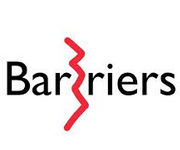
We’ll go into more detail in Part 3 where we get into the whole issue of the brain science of addiction treatment.
But for now, consider the flood of new information and understanding that we’ve gained in just the past ten years – how the brain develops, is structured, functions and continually changes. Think about all the things that everybody knew about the brain, but now they know differently. If you have the time, take a look at some of the reports on how various brain areas talk with each other, share information, grow and change with each new experience and new thing learned.
Then imagine what it means for every person to have a brain that is unique to him or her, allowing each of us to experience events and our environment distinctly. How incredible to have our faith and individual character housed in the final and most advanced region, the focal point for much of our intelligence[xii]; where we form judgments, plan, and reason; where we connect with our motivation, drives, emotions and ultimately bond with those things we choose to need and love; where it can weigh in and influence all that we believe, select, decide and do.
How could anyone who takes the time to understand even this much about our amazing brain think it’s an effect of some cosmic accident, galactic bang or the product of evolutionary selection that now directs our thinking and behavior through a series electrochemical processes. And if God indeed created our brain, would He have designed it as a thing to controls us, or for science to alter and bring into conformity with mans’ idea of normal? No.
I am confident that this one of a kind brain that each of us has, just as it is, is a gift from God, and that He invited us to use it. He said, “let us reason together[xiii],” “let us argue our case together[xiv];” He asked, “what do you think[xv],” and sought “to arouse their clear thinking faculties[xvi],” and taught, “thinking ability itself will keep guard over you, discernment itself will safeguard you.[xvii]” He tells is that “we are His workmanship created in Him to do good works.[xviii]” So why would God give a big share of His people brains with such overwhelming drive that it leads to addiction? He wouldn’t.
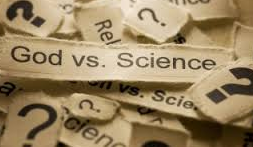 Sadly, the God-Science barrier prevents people on both sides of the fence from looking at the brains of addicted people from God’s perspective, to see each brain’s intended good purpose and learn to reap the benefits of its design. Instead, leaders on both sides buy off on the premise of addiction stemming from a brain system dysregulation. Both work to change the addicted person’s behavior and accommodate the impaired brain.
Sadly, the God-Science barrier prevents people on both sides of the fence from looking at the brains of addicted people from God’s perspective, to see each brain’s intended good purpose and learn to reap the benefits of its design. Instead, leaders on both sides buy off on the premise of addiction stemming from a brain system dysregulation. Both work to change the addicted person’s behavior and accommodate the impaired brain.
Those on the science side of the divide, search for ways to change behavior by pharmaceutically or, in certain cases, surgically altering the brain. While many on the God-fearing side see any efforts to work with the mind/brain as somehow diminishing God’s sovereignty, and instead they choose to focus on faith and prayer as the means to bring about change. The effect is that both sides fail to produce positive and lasting change among people with addiction. It’s like watching two outfielders running to catch the fly ball, only to have it fall right between them. What a waste.
The fact is, when we remove the barrier to view the addicted person’s brain from the perspective of the One who created it and we look for the good and productive things its design allows or encourages, we no longer see a system dysregulation, but rather a purposely driven, highly motivated, human nature. Learning to work with the grain of our brain, as God intended, leads is in new ways to help people fully overcome their addiction and go on to enjoy the fulfilling lives waiting for them.
and we look for the good and productive things its design allows or encourages, we no longer see a system dysregulation, but rather a purposely driven, highly motivated, human nature. Learning to work with the grain of our brain, as God intended, leads is in new ways to help people fully overcome their addiction and go on to enjoy the fulfilling lives waiting for them.
Why those in the addiction industry don’t recognize, from their own research, the flaws in their addiction premise and the futility of their practices, might become more clear as we explore the brain further in Part 3.
[i] Decision making in the Prefrontal Cortex http://sites.duke.edu/huettellab/files/2013/02/2011_Coutlee_BrainResearch.pdf
http://www.sciencedaily.com/releases/2014/11/141126075309.htm
http://neurotheory.columbia.edu/pdfs/SalzmanFusi2010.pdf
[ii] Effect of character on decision making http://www.usna.edu/Ethics/_files/documents/ethical%20decision%20making%20and%20the%20influence%20of%20moral%20intensity.pdf
[iii] Brain hormones and chemicals http://www.brainfacts.org/brain-basics/cell-communication/articles/2012/hormones-communication-between-the-brain-and-the-body/
[iv] Research debunks right brain – left brain personality traits http://healthcare.utah.edu/publicaffairs/news/current/08-14-2013_brain_personality_traits.php
(If you don’t know Jeanne Robertson’s comedy act about her husband, Left Brain, it’s worth a look. www.jeannerobertson.com)
[v] Lateral communication between brain regions http://www.dana.org/Briefing_Papers/Right_Brain-Left_Brain%E2%80%93A_Primer/
[vi] Right brain/left brain debunked http://www.sciencedaily.com/releases/2013/08/130814190513.htm
http://blogs.scientificamerican.com/beautiful-minds/2013/08/19/the-real-neuroscience-of-creativity/ http://www.creativitypost.com/psychology/reasoning_training_increases_brain_connectivity_associated_with_high_level
[vii] http://www.pnas.org/content/111/21/7843.abstract http://www.creativitypost.com/psychology/reasoning_training_increases_brain_connectivity_associated_with_high_level
[viii] Neurogenesis articles, papers regarding identity or character changes
[ix] Neurobiology of individuality and personality; neuroplasticity allows continuous change http://www.psychologytoday.com/blog/the-athletes-way/201305/neuroscientists-discover-keys-individual-personality
xDana Foundation study on changing our individuality
One of a Kind, The Neurobiology of Individuality, Richard J. Davidson, PhD
[xi] Complaint of Psychology regarding biology of brain overriding processes of the mind http://www.ncbi.nlm.nih.gov/pmc/articles/PMC3177535/
[xii] PFC and intelligence http://www.jneurosci.org/content/32/26/8988.abstract
[xiii] Isaiah 1:18
[xiv] Isaiah 43:26
[xv] Matthew 17:25; 18:12; 21:28; 22:42
[xvi] 2 Peter 3:1
[xvii] Proverbs 2:11, 12
[xviii] Ephesians 2:10

